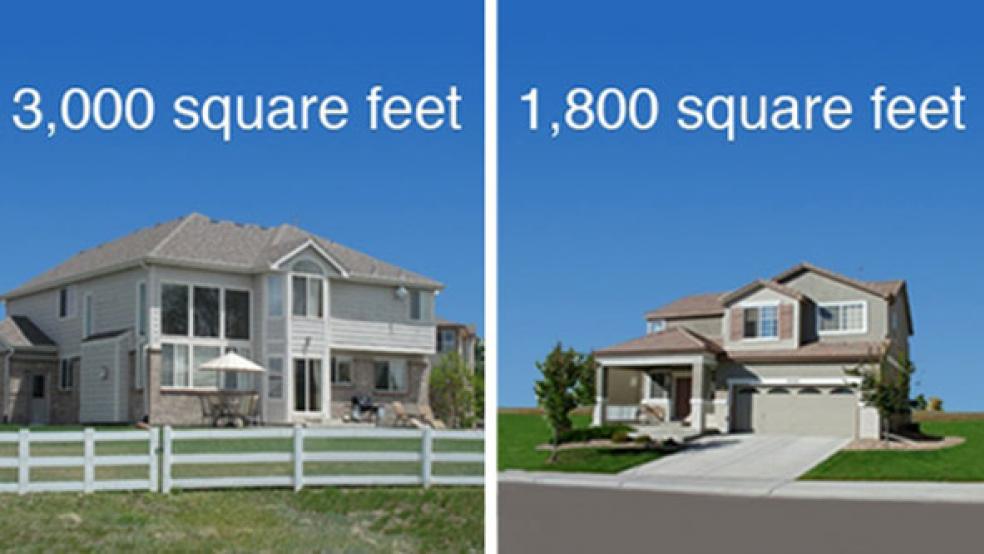Jeff Nielsen lives in Thornton, Colorado, and speaks in slow, relaxed cadences speckled with “awesome” and “man.” He cooks dinner at home, volunteers, and plays tennis. He’s tan and younger-looking than his 37 years, and appears not to have a worry in the world.
Two and a half years ago, life was more complicated. On the outside, he had it all: a gorgeous wife, a newborn son, a shiny new $50,000 Lexus and a $30,000 Acura, and a, 3,000-square-foot, four-bedroom house with a quarter-acre backyard, mountain views and a home theatre.
But on the inside, something didn’t feel right. To maintain his lifestyle, he’d occasionally put in 15-hour days selling zero-down mortgages in the midst of the booming Colorado subprime mortgage industry, to families with little or no savings. He was taking home an average $400,000 a year, but paying $3,200 a month in mortgage payments, $1,000 in car payments, and $240 a month just for upkeep on the backyard. “I had all this stuff. I had this vision that I was ahead of the game.”
One dreary day in December 2007, he arrived at the office and his coworkers were cleaning out their desks. The company, First Franklyn Mortgage Corporation, one of the first in a line of collapsing mortgage companies, was bankrupt. Losing his job and his hefty salary was tough, but Nielsen bounced back quickly and went to sell mortgages at Lehman Brothers, thinking big established banks offered security. But, of course, less than a year later Lehman went bankrupt as well. “A light bulb went on,” he recalls. “I just kind of looked in the mirror and said, you know what? Let’s just go simple.”
And simple they went. He and his wife put their house on the market, started a tennis apparel company, and gathered up their savings to travel to Thailand for three weeks. They traded in the Lexus and the Acura for a $6,000 used 1998 Mercedes. They sold half their furniture and moved into a rental property purchased in 2003—a more modest 1,800-square-foot, three-bedroom with a tiny backyard.
The Nielsens are among a growing number of American families who, even as the economy begins to recover, are stepping back from the exhausting ascent toward bigger and better. They’re moving to smaller homes, selling valuables, slashing bills, eating out less and making small adjustments to simplify their lives, and in the process, changing their attitudes toward the meaning of success and the American dream.
Movin’ on Down
In some 40 years, the average size of American homes nearly doubled, from 1,500 square feet in 1970 to 2,500 square feet in 2007. In sunbelt cities like Scottsdale, Arizona, 4,500 square-foot mega-homes were being built before the housing bust. And let’s not forget the McMansions —the 10,000 square feet monstraosties that blighted the suburban landscape on land parcels far too small for their footprints. But recent data shows that Americans are finally starting to go smaller. From 2007 to 2008, the average size of single-family homes, went from 2,507 square feet to 2,463, the largest decline since 1973. In 2009, it fell to 2,373. In the Northeast, known for its stately colonial homes, the average size peaked in 2008 at 2,684 square feet and fell to 2,570 last year.
A January 2010 survey by the National Association of Home Builders (NAHB) found that 90 percent of its members were building smaller developments. “Affordability drives the decisions,” says Stephen Melman, an economic and housing policy analyst at the Association. “A home that’s a little smaller will cost a little less and will cost less to heat and cool it during the year.”
In 2007, a group of industry experts from the NAHB Economics Group predicted that average homes would return to around 2,300 square feet in 2015. “The average household size has been declining for the past 35 years, dropping from 3.11 in 1970 to 2.59 in 2004. This means that people have been buying larger homes for lifestyle considerations rather than to meet a functional need for space,” the report said.
Even as the housing market shows signs of recovery and Americans reemerge from the rubble, 15 million people still owe more on their mortgages than their homes are worth, the number of homeowners defaulting on their mortgages nearly doubled last month, and bank loans are now much more difficult to obtain. It’s no wonder Americans are downsizing and giving up their free-spending ways.
The Swinging Pendulum
Downsizing isn’t new. There have been dips in consumer spending and a waning of materialism in previous recessions. Most recessions have shown a temporary drop in the average home size. During the high inflation energy crisis in the early 1980s, home sizes declined by about 10 square feet each year from 1979 to 1982 before ticking back up. Then in 1990 and again in 1994, housing had a small hiccup, each time falling five square feet for only a year.
Will downsizing last this time? Penny-pitching during this recession was to be expected, but consumer spending has already started to creep up again, growing at an annual rate of 3.6 percent in the first quarter of 2010. Spending on luxury goods is up again, too, and saving is down: Americans were saving 6.4 percent of their disposable income in May 2009, but the rate has dropped steadily since and in February 2010, was down to 3.1 percent.
Melman at the NAHB believes that although home sizes are decreasing more than before, there are a variety of temporary factors in addition to the economic downturn: Baby boomers are becoming empty nesters and no longer need five bedrooms. The first-time homebuyer tax credit prompted a surge of people buying starter homes, which naturally tend to be less expensive and smaller. He thinks more buyers will trade up as the economy improves.
Chris Farrell, the author of a 2009 book “The New Frugality,” disagrees. He argues there was a shift towards simplification and sustainability even before the recession. “What recessions often do is they accelerate some underlying trends that were already there in the economy or culture,” he says. “They looked around their home, their apartment, and said ‘why do I have all these things?’” According to Farrell, downsizing equals more freedom—freedom from bills, stress, a bad job. “We live in a world where you can’t control the business cycle, you can’t control what’s happening in the stock market. By downsizing and saving, you gain control.”
Land of the Free
For Jeff Nielsen, the first step—selling the Lexus—was the hardest, but once it was gone, the purging of his extraneous belongings came easy. “It was this incredible sense of freedom coming off my shoulders,” he said. “Once the vehicles were gone, I had this money in the bank and I was like, this is incredibly awesome.”
Their new smaller house is closer to the elementary school, letting Nielsen and his wife walk their son to school every day. His mortgage payment is down to $1,500 a month, less than half the old one. The homeowners’ association takes care of all the yard maintenance. At one point, the Nielsens were eating out four times a week or more, dropping at least $200 each time. Now, it’s maybe once every two weeks and they cook at home constantly. The other night, inspired by Anthony Bourdain on the Travel Channel, Nielsen and his wife attempted homemade pasta. “I ran to the supermarket, got the ingredients, we cooked the spaghetti for an hour together, and our son was there playing and loves to jump up on the counter and stir. It was the best spaghetti I’ve ever had in my life.”





